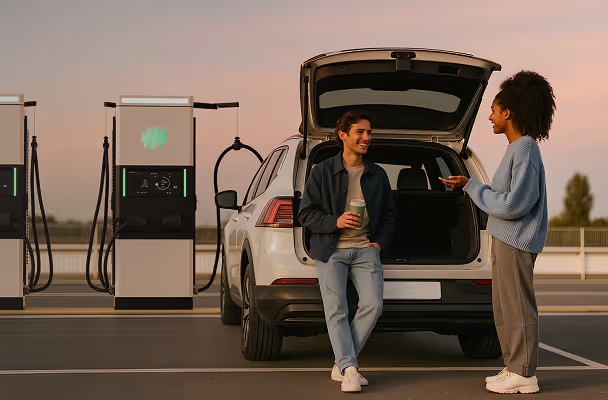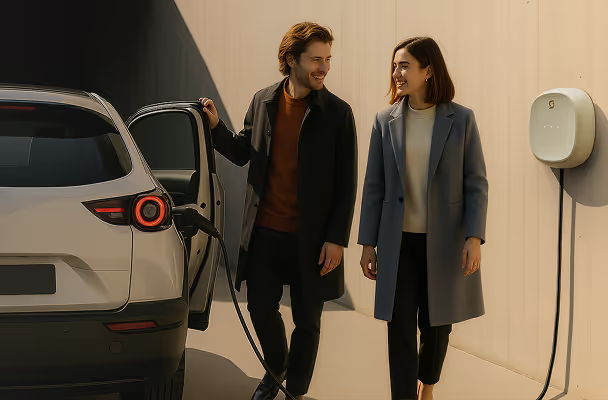The Current Status of DC Fast Charging
.avif)
In 2024, 17.1 million EVs were sold globally. Out of these over 1.5 million EVs were sold in India alone, which is a 50% jump from the previous year. These numbers look promising, as India moves towards its goal of 30% EV penetration in all segments by 2030.
However, EV charging stations have not been able to instill high confidence in users due to an apparent lack of information and guidance. In a survey by Deloitte, over 39% of ICE vehicle owners cited long charging times as a primary reason for not switching to EVs. 38% said that they get range anxiety due to lack of reliable public charging facilities. After all, what will one do with a world class water purifier, if there is no running water in the house?
But this scenario is seeing interesting changes, as more and more countries undertake EV adoption through best practices, policy implementation, and technological developments.
So, what are these changes?
Public charging infrastructure is growing exponentially.
China is building at lightning speed.
With 760,000 DC fast chargers by end of 2023 and numerous projects in the pipeline, China’s grid is quickly integrating fast charging with real-time monitoring to ensure high charger density along highways and urban clusters. What truly sets China apart, however, is not just the scale but the speed of deployment. Thanks to streamlined regulatory frameworks, abundant skilled labor, and vertically integrated supply chains, China can roll out new charging stations in a matter of weeks, far faster than most developed markets.
Europe is making interoperability the norm.
The European Union has enacted the Alternative Fuels Infrastructure Regulation (AFIR), which mandates the installation of high-power (150 kW+) DC fast chargers at least every 60 km along the core Trans-European Transport Network (TEN-T) corridors by 2025, while also requiring interoperability and transparent pricing to enhance user convenience and cross-border compatibility. This initiative aims to ensure seamless long-distance travel for EVs across member states. Europe has already surpassed 90,000 public DC fast chargers, reflecting this accelerated infrastructure rollout.
The US is investing in uptime and smart diagnostics.
The NEVI program is deploying EV DC fast charging every 50 miles along major highways, with $5 billion in funding and more than 98% uptime on networks like Tesla Superchargers.
As of 2023, the ratio of electric vehicles to public charging stations is 9:1 in China, a significant improvement from 17:1 in 2018. In these 5 years, this ratio has improved from 30:1 to 17:1 in Europe, and from 36:1 to 26:1 in the United States.
This begs the question: What is the current state of EV ecosystem in India?
India’s rapid DC Fast Charging developments for EVs
India’s government is pushing hard, with bodies like FAME-II, state EV policies, and many public-private partnerships working actively to promote EV adoption. As of early 2024, India has 12,146 public EV charging stations and 1,500 of them are DC fast chargers. This is a massive, almost unbelievable 9-fold growth in 5 years. But, due to the high population of India, the EV-to-public charger ratio stands at a high of 135:1.
.png)
India’s charging infrastructure is among the fastest growing but underutilized. This is due to a multitude of reasons.
Factors limiting the full potential of DC Fast Charging in India
- Charging cables can be incredibly heavy, weighing as high as 15-20kgs. This makes it difficult for senior citizens and the specially abled to use them. However, modern day chargers have mechanically supported cable management systems which do not require users to do any heavy lifting. Even the retraction and plugging are assisted, making charging a comfortable experience for all. Multiple manufacturers in the US, Germany and France are developing this system to make charging safe and easy- unsupervised.
- Most charging sites operate without on-site staff. This leads to confusion among users about how to initiate charging, select the correct connectors, and complete payment. Multiple apps with inconsistent interfaces further complicate the charging process, causing frustration and delays.
- The uptime of chargers in India is less than the global average. 95% of the issues that crop up in DC fast chargers are almost completely avoidable, but the lack of predictive maintenance leads to breakdowns for every other issue. Predictive maintenance is a technology that leverages AI-ML to monitor charging components, detect faults, and provide remote support as required. Manufacturers in Europe and Australia have achieved as high as 99% uptime by using these.
- Users often have problems using electric chargers due to poor lighting at night. This deters them from choosing EVs for longer drives.
So how do we overcome these limiting factors?
Technology that paves the way forward for India:
Challenges like heavy cables, confusing payment systems, frequent downtime and low-light inconvenience are now going to be in the past, as smarter solutions have entered the market. Exicom’s Harmony Direct 2.0 is one such product that is transforming how DC fast charging works. Mechanically supported cable handling and a seamless user interface, which is just like a smartphone, makes charging accessible to a diverse base of users. Using predictive maintenance, it assures reduced downtime by 30%. Moreover, its ambient lighting is designed not just for aesthetics, but for visibility and safe functioning 24*7. By making charging faster, easier, and more reliable, it’s helping power India’s electric future and driving the shift toward cleaner, smarter mobility.
Discover how Harmony Direct 2.0 can power your journey.

Glossary
- DC Fast Charging: High-speed charging using direct current, enabling rapid EV battery replenishment.
- Interoperability: The ability of different EVs and chargers to work seamlessly together.
- Dynamic Load Sharing: Distributing available power among multiple chargers to optimize efficiency.
- Predictive Maintenance: Using AI to anticipate and prevent equipment failures.
Bibliography
International Energy Agency. (2024). Global EV Outlook 2024.
FADA (Federation of Automobile Dealers Associations of India)
Does DC Fast Charging Degrade Tesla Batteries?
Uland Power Blog : EV Charging Trends in India.
Auto Update Daily: EV Charging Stations in India: Progress & Challenges.
EU Transport – Alternative Fuels Infrastructure Regulation (AFIR) and EV Charging
EVReporter – Operational Public EV Charging Stations Nationwide
Hindustan Times Auto – Does India have adequate EV charging infrastructure? Key challenges
Fortune India – Why EV Charging Infra Rots
CEEW – Recommendations for Seamless Adoption of EV Charging Infrastructure in India (2023)
Changing Transport – Recommendations for Seamless Adoption of EV Charging Infrastructure in India
Exicom – Harmony Direct 2.0: The DC Fast Charger Driving India's EV Future
Frequently Asked Questions
Lorem ipsum dolor sit amet, consectetur adipiscing elit, sed do eiusmod tempor incididunt ut labore et dolore magna aliqua. Ut enim ad minim veniam, quis nostrud exercitation ullamco laboris nisi ut aliquip ex ea commodo consequat. Duis aute irure dolor in reprehenderit in voluptate velit esse.
Lorem ipsum dolor sit amet, consectetur adipiscing elit, sed do eiusmod tempor incididunt ut labore et dolore magna aliqua. Ut enim ad minim veniam, quis nostrud exercitation ullamco laboris nisi ut aliquip ex ea commodo consequat. Duis aute irure dolor in reprehenderit in voluptate velit esse.
Lorem ipsum dolor sit amet, consectetur adipiscing elit, sed do eiusmod tempor incididunt ut labore et dolore magna aliqua. Ut enim ad minim veniam, quis nostrud exercitation ullamco laboris nisi ut aliquip ex ea commodo consequat. Duis aute irure dolor in reprehenderit in voluptate velit esse.
Lorem ipsum dolor sit amet, consectetur adipiscing elit, sed do eiusmod tempor incididunt ut labore et dolore magna aliqua. Ut enim ad minim veniam, quis nostrud exercitation ullamco laboris nisi ut aliquip ex ea commodo consequat. Duis aute irure dolor in reprehenderit in voluptate velit esse.
Lorem ipsum dolor sit amet, consectetur adipiscing elit, sed do eiusmod tempor incididunt ut labore et dolore magna aliqua. Ut enim ad minim veniam, quis nostrud exercitation ullamco laboris nisi ut aliquip ex ea commodo consequat. Duis aute irure dolor in reprehenderit in voluptate velit esse.



